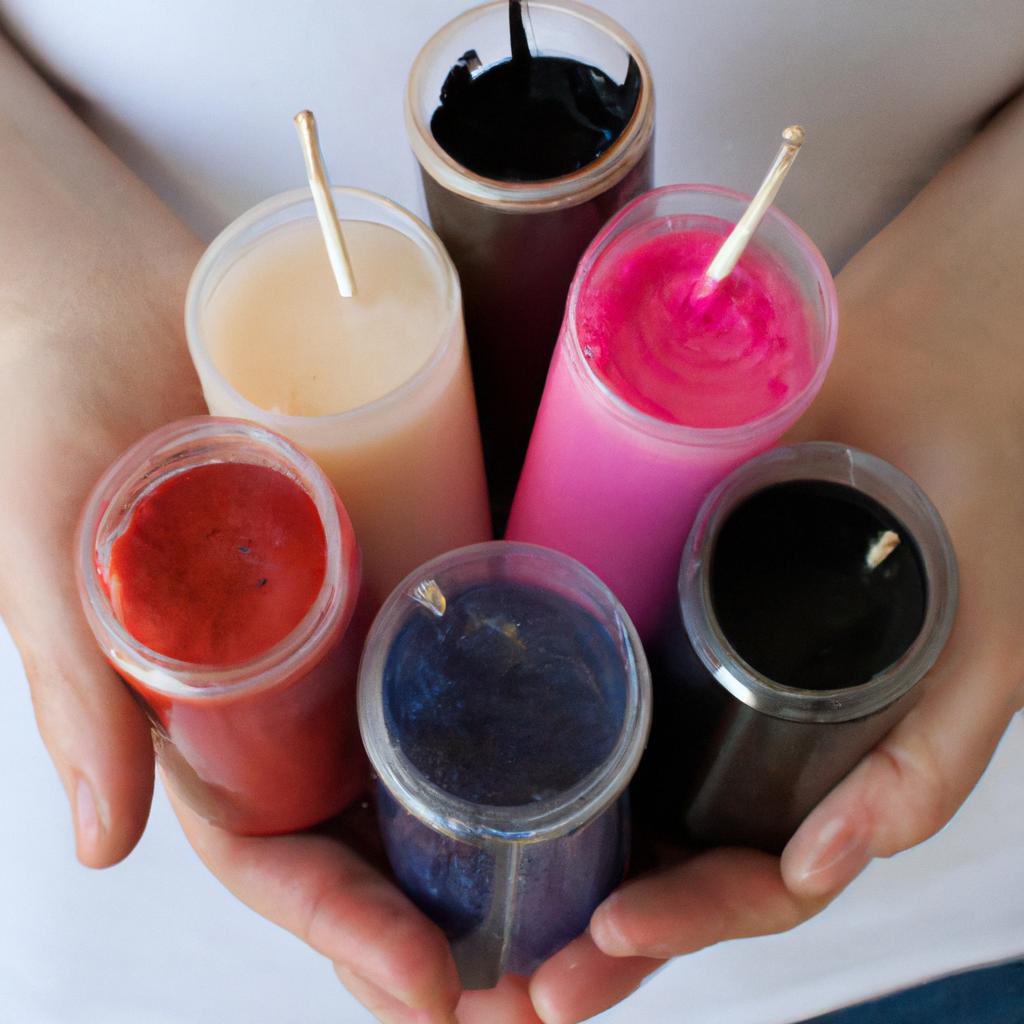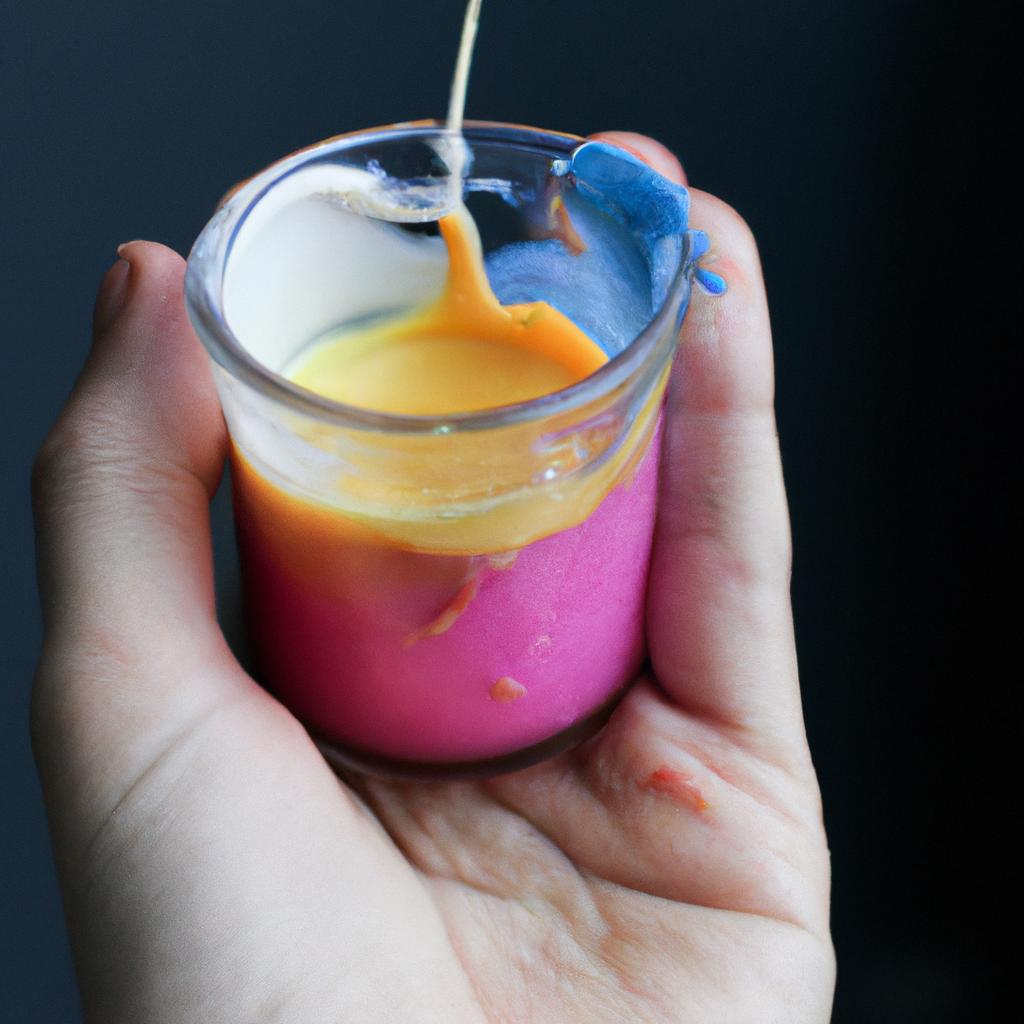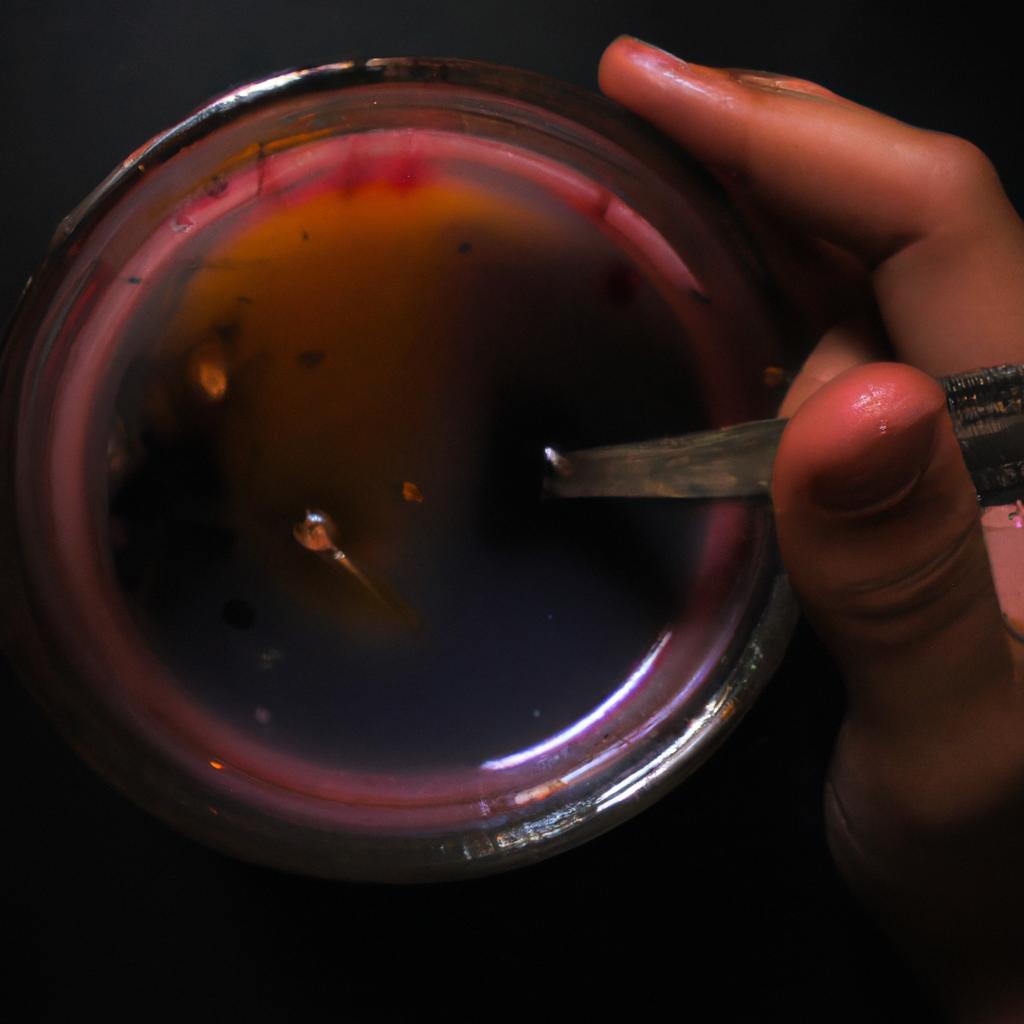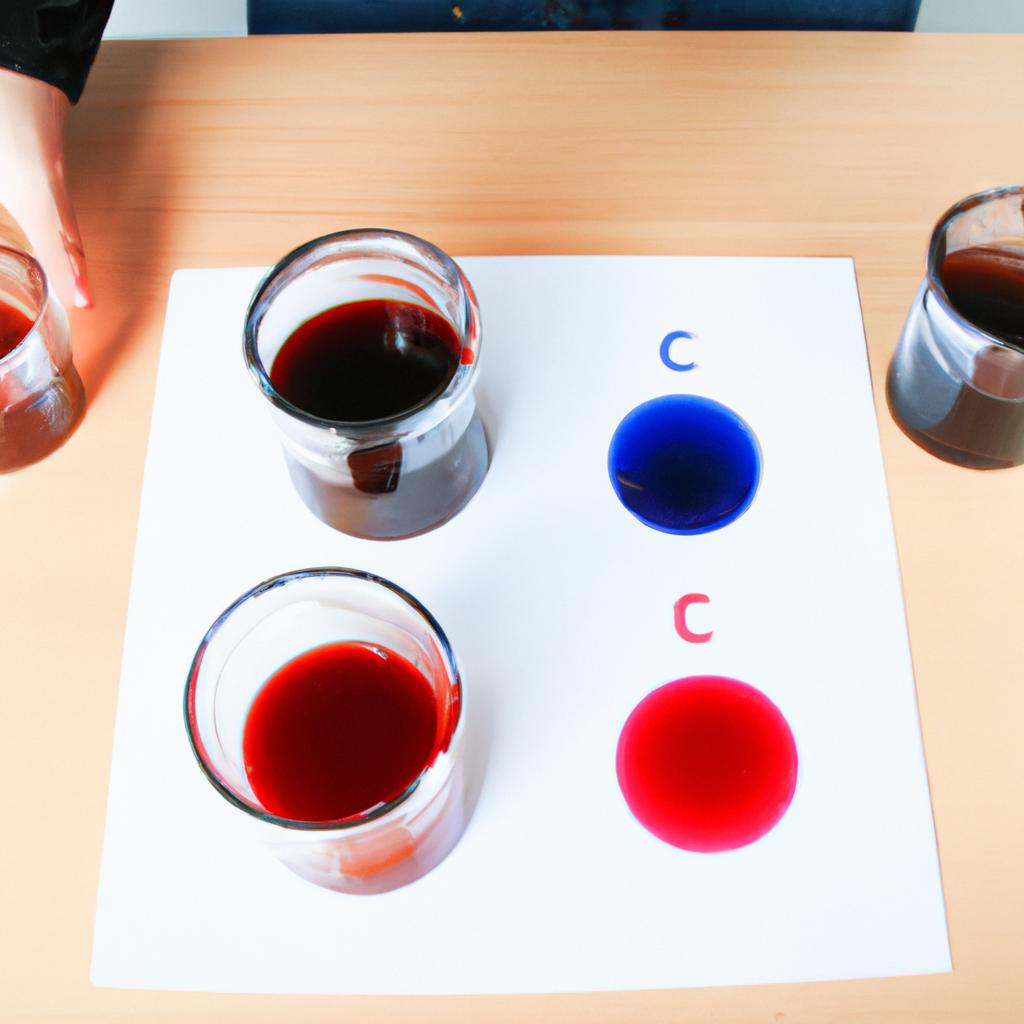Dye-to-Wax Ratio: The Balance in Candle Making
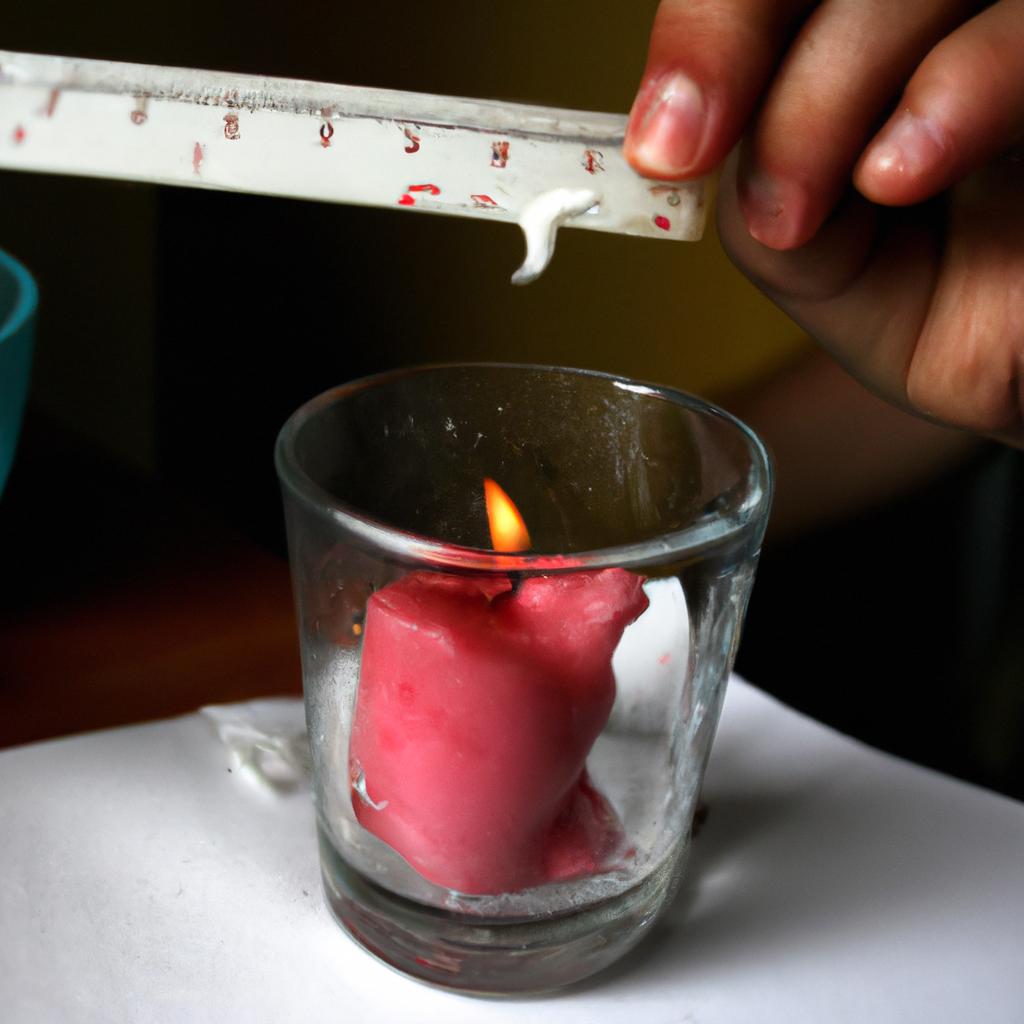
Candle making is an age-old craft that has evolved over centuries, with artisans constantly seeking ways to enhance the aesthetic appeal of their creations. One crucial aspect in candle making is achieving the perfect balance between dye and wax ratio. This delicate equilibrium plays a significant role in determining the overall quality and visual impact of the finished product. For instance, imagine a scenario where an artisan aims to create a vibrant purple candle using a high concentration of dye-to-wax ratio. In this case, if the proportion of dye used exceeds what the wax can absorb or bind effectively, it may lead to uneven distribution of color, resulting in an unattractive final appearance.
A well-executed dye-to-wax ratio not only ensures consistent color intensity but also contributes to even burning characteristics and prolonged burn time. Striking this balance requires careful consideration of multiple factors such as type and quality of dyes, types of waxes utilized, desired shade intensity, and personal preferences regarding scent release during combustion. Furthermore, various techniques exist for incorporating dyes into candles. Some artisans prefer adding dyes directly into melted wax while others opt for pre-dyeing the solid wax before melting it down for further processing. Regardless of the approach taken, understanding how different ratios influence the outcome allows the artisan to create candles that are visually appealing, consistent in color, and meet their desired aesthetic goals.
To achieve the perfect dye-to-wax ratio, it is essential to start with high-quality dyes specifically formulated for candle making. These dyes should be able to disperse evenly throughout the wax without clumping or settling. It is advisable to follow the manufacturer’s instructions for recommended dye-to-wax ratios as a starting point.
Experimentation is key when determining the ideal ratio for a specific shade or hue. Start with a small batch and gradually increase or decrease the amount of dye until the desired color is achieved. Keep in mind that different dyes may require different ratios, so it’s important to keep track of measurements and observations for future reference.
The type of wax used also plays a role in determining the appropriate dye-to-wax ratio. Some waxes have better dye absorption properties than others, so adjustments may be necessary depending on the chosen wax. Additionally, certain waxes may require higher concentrations of dye to achieve vibrant colors, while others may produce more intense shades with lower amounts.
Personal preferences regarding scent release during combustion should also be considered. Some dyes can affect the fragrance throw of a candle, either enhancing or masking it. It is crucial to find a balance between color intensity and scent performance based on individual preferences.
Overall, achieving an optimal dye-to-wax ratio requires attention to detail, experimentation, and an understanding of how different factors influence color distribution and burning characteristics. With practice and experience, artisans can master this delicate equilibrium and create visually stunning candles that delight both visually and aromatically.
Importance of Dye-to-Wax Ratio
Imagine a scenario where two candle makers are using the same type of wax and dye to create their candles. The first one carefully measures out the recommended amount of dye, while the second one adds an excessive amount for a bolder color. After pouring their respective mixtures into molds and allowing them to solidify, they notice distinct differences in the final products. The first candle has a vibrant hue that evenly permeates throughout, while the second candle appears blotchy and unevenly colored.
The above example highlights the significance of maintaining an appropriate dye-to-wax ratio in candle making. The balance between these two components directly affects not only the aesthetic appeal but also the overall quality of the finished product. To emphasize this point further, consider the following bullet points:
- Consistency: Achieving consistency in color is essential as it enhances visual appeal and provides a professional finish.
- Even Distribution: Properly blending dyes with wax ensures even distribution of color throughout the entire candle, resulting in a more visually pleasing end product.
- Longevity: Balancing dye-to-wax ratio helps preserve color over time, preventing fading or discoloration due to exposure to light or heat.
- Customer Satisfaction: A well-executed dye-to-wax ratio contributes to customer satisfaction by delivering aesthetically appealing candles that meet expectations.
To illustrate how different ratios can impact the outcome, let’s examine a hypothetical table demonstrating various combinations and their corresponding effects on appearance:
| Dye (grams) | Wax (grams) | Resulting Color |
|---|---|---|
| 1 | 100 | Pale shade |
| 2 | 100 | Subtle tint |
| 5 | 100 | Vibrant tone |
| 10 | 100 | Intense saturation |
As seen from the table, varying the dye-to-wax ratio significantly alters the resulting color intensity. This underlines the importance of finding the right balance to achieve desired outcomes.
In understanding the significance of maintaining an appropriate dye-to-wax ratio in candle making, it becomes evident that this aspect plays a crucial role in determining the overall quality and aesthetic appeal of candles. In light of these observations, exploring the factors influencing this delicate equilibrium is essential for aspiring candle makers seeking optimal results. Therefore, let us now delve into a discussion on factors affecting dye-to-wax ratio without delay.
Factors Affecting Dye-to-Wax Ratio
Importance of Dye-to-Wax Ratio in Candle Making
Achieving the proper dye-to-wax ratio is crucial for candle makers as it directly affects the appearance and color intensity of their creations. The balance between these two components determines whether a candle will have vibrant hues or muted shades, making it an essential consideration in the candle-making process.
To illustrate this point, let’s consider a case study where two candle makers, Alice and Bob, used different dye-to-wax ratios to create blue candles. Alice followed a recommended ratio of 1:10 (dye:wax), while Bob decided to experiment with a higher concentration by using a 1:5 ratio. As a result, Alice’s candles had a soft sky-blue shade, providing a calming ambiance when lit. On the other hand, Bob’s candles turned out much darker than desired, resembling deep ocean tones rather than the serene blue he intended.
Several factors contribute to finding the optimal dye-to-wax ratio for each batch of candles:
- Wax type: Different waxes have varying absorption capacities for dyes. Soy wax may require less dye compared to paraffin wax due to its porous nature.
- Dye type: Various types of dyes are available for coloring candles such as liquid dyes or color blocks. Each variant has specific instructions regarding usage quantities based on their composition.
- Desired color intensity: Depending on personal preferences or product requirements, some individuals might prefer more intense colors that necessitate higher dye concentrations.
- Quality control: Regularly testing small samples with different dye-to-wax ratios enables candle makers to assess how various combinations affect final outcomes before committing to larger batches.
| Factors Affecting Dye-to-Wax Ratio |
|---|
| Wax Type |
| Dye Type |
| Desired Color Intensity |
| Quality Control |
Understanding these factors enables candle makers to make informed decisions regarding their dye-to-wax ratios, resulting in visually appealing candles that meet customer expectations.
Tips for Achieving Proper Dye-to-Wax Ratio
In the previous section, we discussed the importance of maintaining a proper dye-to-wax ratio in candle making. Now, let us delve deeper into some key factors that can significantly influence this balance.
One factor to consider is the type and color intensity of the dye being used. Different dyes have varying levels of concentration, requiring adjustment in the amount added to achieve desired results. For instance, a highly concentrated dye may require a smaller quantity compared to a less concentrated one. Additionally, certain colors may appear more vibrant when combined with different waxes or additives, necessitating further adjustments to maintain an optimal ratio.
Another crucial consideration is the type of wax being utilized. Each wax has its own unique characteristics that can impact how it interacts with dyes. Soy wax, for example, tends to hold onto color more effectively than paraffin wax due to its porous nature. Consequently, candle makers need to account for these variations by adjusting their dye-to-wax ratios accordingly.
Furthermore, the shape and size of the candles also play a role in determining the appropriate dye-to-wax ratio. Larger candles typically require higher amounts of dye compared to smaller ones in order to achieve uniform color distribution throughout the entire volume. Similarly, intricate designs or multi-colored patterns may necessitate precise calculations and measurements to ensure consistency across each individual element.
To emphasize the significance of achieving an ideal balance in your dye-to-wax ratio, consider these emotional responses:
- Exquisite hues that captivate and transport you into moments of tranquility.
- Vibrant shades igniting joy and warmth within your living space.
- Meticulously crafted candles reflecting elegance and artistic flair.
- Harmonious blends that evoke nostalgia and create cherished memories.
Below is a table illustrating various types of dyes commonly used in candle making along with recommended ranges for their respective dye-to-wax ratios:
| Type | Recommended Range |
|---|---|
| Liquid Dye | 0.5% – 2% |
| Block/Powder | 0.05% – 1% |
| Chip/Flake | 0.25% – 3% |
| Color Blocks | Varies |
As candle makers, it is essential to understand that achieving a proper dye-to-wax ratio requires careful consideration of these factors and emotional connections associated with vibrant colors and exquisite designs. By maintaining this balance, you can create candles that not only illuminate spaces but also evoke emotions and memories.
Common Mistakes in Dye-to-Wax Ratio
As candle makers strive for the perfect balance in their craft, achieving a proper dye-to-wax ratio is essential. In our exploration of this crucial aspect, we have discussed various tips to help you attain the desired outcome. Now, let us delve into some common mistakes that can result in an imbalanced dye-to-wax ratio.
To illustrate the impact of incorrect ratios, consider the following hypothetical scenario. A novice candle maker eagerly prepares to produce a batch of vibrant purple candles using a specific dye-to-wax ratio recommended by an online tutorial. However, due to a miscalculation or misinterpretation, she mistakenly adds twice as much dye as required. The consequence? Instead of elegant shades of violet, her candles turn out dark and unappealingly dense.
It is vital to be aware of these pitfalls when aiming for optimal results. Here are several common mistakes made during the dye-to-wax mixing process:
- Rushing through measurements without precision.
- Failing to account for variations based on different wax types.
- Overcompensating with more dye if initial color appears lighter than expected.
- Neglecting to thoroughly mix the dye and wax together before pouring.
Understanding these potential errors will allow candle makers to navigate around them effectively. Moreover, it is crucial to acknowledge that even minor deviations from the recommended ratios can yield significant differences in the final outcome.
| Possible Consequence | Imbalanced Dye-to-Wax Ratio |
|---|---|
| Uneven coloring | Dark patches or streaks |
| Poor fragrance retention | Weak scent throw |
| Reduced burn time | Excessive soot formation |
| Wax pooling | Uneven melting patterns |
Being mindful of such consequences helps emphasize the importance of maintaining precise dye-to-wax ratios throughout every step of the candle making process. By paying attention to these details, you can create stunning candles that captivate both visually and aromatically.
Understanding the potential pitfalls of an imbalanced dye-to-wax ratio sets the stage for exploring its effects on candle quality. In our next section, we will delve into how deviations in this ratio impact various aspects of candle performance.
Effects of Imbalanced Dye-to-Wax Ratio
One common mistake that candle makers often make is using an imbalanced dye-to-wax ratio. This can significantly impact the quality and appearance of the finished candles. Let’s take a look at an example to understand this better.
Imagine a scenario where a candle maker wants to create vibrant blue candles using dye chips. They decide to use two dye chips per pound of wax based on their previous experience with other colors. However, they fail to consider that certain colors may require different ratios for optimal results. As a result, their blue candles turn out dull and faded instead of the vibrant shade they were aiming for.
To avoid such disappointments, it is important to understand the effects of an imbalanced dye-to-wax ratio. Here are some key points to consider:
- Insufficient Dye: Using too little dye relative to the amount of wax will result in pale or washed-out coloration.
- Excessive Dye: Conversely, adding too much dye can lead to bleeding or uneven coloring, as well as potential issues with fragrance retention.
- Color Variation: Different dyes have varying concentrations and compositions, meaning each one may require its own specific ratio for desired outcomes.
- Wax Type: The type of wax being used can also influence how dyes interact with it, so it is essential to account for these variations when determining the appropriate ratio.
To illustrate these effects further, let’s examine a comparison table showcasing three different scenarios of dye-to-wax ratios:
| Dye-to-Wax Ratio | Resulting Candle Color | Appearance |
|---|---|---|
| 0.5% | Pale shade | Lackluster |
| 2% | Rich and vibrant | Desired outcome |
| 5% | Bleeding and patchy | Uneven coloring |
As you can see, finding the right balance in the dye-to-wax ratio is crucial for achieving desired results. By understanding and avoiding these common mistakes, candle makers can enhance their skills and produce high-quality candles with consistent colors.
Transitioning to the next section on “Experimenting with Dye-to-Wax Ratio,” it becomes evident that there is room for exploration and improvement when it comes to finding the ideal dye-to-wax ratio. Through experimentation, candle makers can fine-tune their techniques and discover new possibilities in color customization. Let’s delve into this exciting aspect of candle making without delay.
Experimenting with Dye-to-Wax Ratio
In candle making, achieving the perfect dye-to-wax ratio is crucial for creating beautiful and balanced candles. Let’s delve deeper into some specific consequences that may arise from an improper dye-to-wax ratio.
One example that highlights the importance of a balanced ratio is the case of Sarah, an experienced candle maker who decided to experiment with different dye concentrations in her wax. She increased the amount of dye significantly without adjusting the wax proportion accordingly. The result was vibrant-colored but weak and brittle candles that had a shorter burn time than usual. This demonstrates how an excessive dye concentration can compromise the structural integrity of candles.
To better understand the potential effects of an imbalanced dye-to-wax ratio, consider the following points:
- Uneven color distribution: When there is too much or too little dye relative to the quantity of wax used, it can lead to uneven coloring in finished candles.
- Scent interference: An imbalanced ratio could also hinder proper scent throw in scented candles since dyes might interfere with fragrance oils present in the wax.
- Wax pooling: Excessive amounts of dye can cause faster melting and greater heat emission by altering the properties of wax, which may result in unwanted wax pooling around the wick.
- Reduced stability: A disproportionate amount of dye might weaken the overall structure and reduce durability, leading to fragile and easily breakable candles.
To illustrate these potential outcomes visually, refer to Table 1 below:
| Effect | Dye Concentration (Excessive) | Dye Concentration (Insufficient) |
|---|---|---|
| Color Distribution | Uneven | Lackluster |
| Scent Throw | Hindered | Unaffected |
| Wax Pooling Around Wick | Increased | Minimal |
| Candle Stability | Weakened | Unaffected |
Table 1: Effects of imbalanced dye-to-wax ratio on candle properties.
Considering the detrimental effects discussed above, it becomes evident that maintaining a proper balance between dye and wax is essential in candle making. Achieving this balance ensures not only aesthetically pleasing candles but also ones that burn evenly, emit fragrance effectively, and have enhanced structural integrity for longer-lasting enjoyment. Therefore, meticulous attention to the dye-to-wax ratio should always be exercised to produce high-quality candles.

